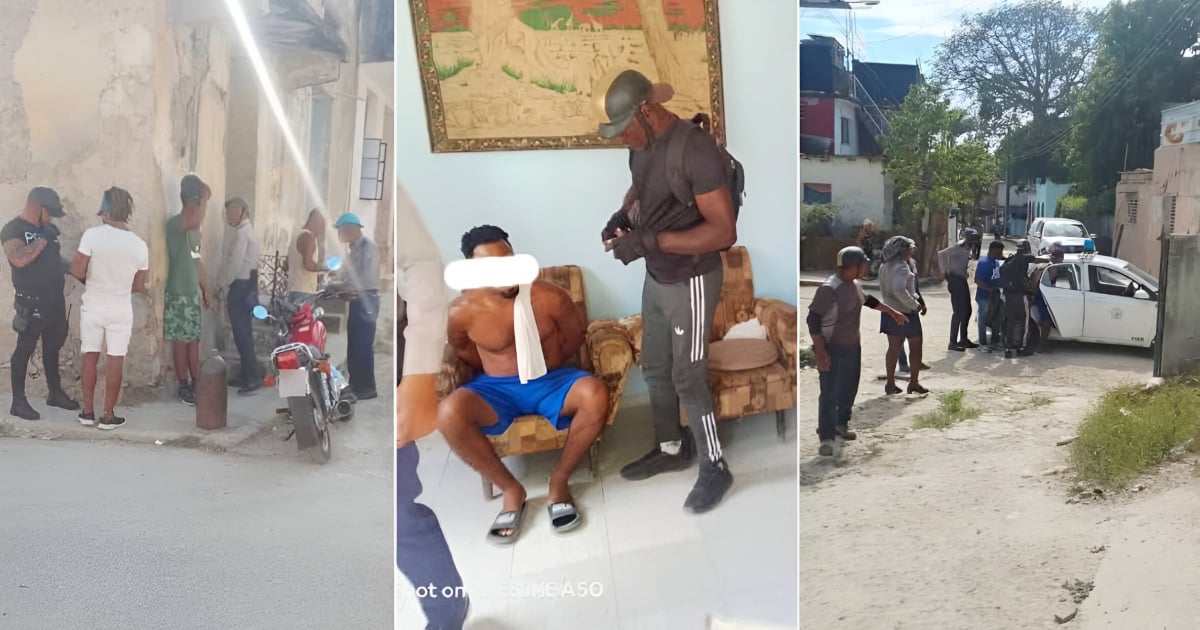This week, a significant anti-drug operation in Havana led to the arrest of numerous individuals, according to reports from various official social media profiles. These sources have shared images and provided details about some of the arrests. The operations were conducted across different areas of Havana, including Marianao, Guanabacoa, East Havana, Old Havana, Arroyo Naranjo, Cerro, and Boyeros, among others.
The operation strategy involved surprise raids, during which police confiscated drugs, cash, and materials used for the distribution of illegal substances. In the Boyeros municipality, the Sector Chief of the Wajay district caught a trafficker in the act, seizing 128 packets of the cannabinoid known as "the chemical." Another location with multiple drug-related arrests was La Güinera, in the Arroyo Naranjo municipality. Among those arrested were Marnoldis Utria and Luis Echarte Cruz. According to residents' testimonies, Marnoldis was caught with two cigarettes, one of which contained "the chemical."
Meanwhile, Luis Echarte Cruz was apprehended after a digital scale, three metal scissors, and an ashtray filled with material ready for sale were found in his home. Another operation took place in the Martí district of the Cerro municipality, where police seized a substantial amount of "chemical" and marijuana, along with national and U.S. currency. In this case, only one trafficker, known as "Yosvanis," who was already notorious for his criminal activities in the area, was arrested.
In the neighborhood of La Favela, at Callejón El Sapo, in the Guanabacoa municipality, police successfully confiscated a significant quantity of the popular cannabinoid "the chemical." The operation led to the arrest of brothers Pablo Alexis and Ernesto. Besides the drug, officers found cuttings and packets used for distribution.
On Tuesday night, Cuban police conducted another anti-drug operation in the East Havana municipality, arresting several individuals for allegedly possessing illicit substances and controlled medications. Earlier that day, operations in Marianao and Guanabacoa resulted in the arrest of several suspects linked to drug trafficking. Earlier in the week, an operation at Quinta Corona in the D’Beche district of Guanabacoa concluded with the detention of two suspects.
Authorities have urged the public to report any suspicious activities related to drug sales and consumption, highlighting the importance of citizen cooperation in eradicating this issue. A judge from the Supreme Court stated that one of the biggest challenges in prosecuting these crimes is the need for solid evidence to secure convictions. Therefore, evidence collection is crucial to the success of these operations.
Rising Anti-Drug Operations in Cuba
At the beginning of December, it was revealed that Marianao, La Lisa, Arroyo Naranjo, and San Miguel del Padrón are the municipalities with the highest drug trafficking and consumption rates in Havana, according to a colonel from the Ministry of the Interior (MININT) on the television program "Hacemos Cuba," hosted by regime spokesperson Humberto López. "These areas are hubs of trafficking. There is a consumption culture. The main traffickers and consumers are located here," explained Colonel Juan Carlos Poey, head of the specialized anti-drug unit.
Moreover, he noted that in the neighborhoods of La Güinera (Arroyo) and El Palenque (La Lisa), methamphetamine consumption has been detected, indicating that drug addiction has escalated from synthetic cannabinoids to methamphetamines (pills, powders, or stimulant crystals). This is because addiction demands increasingly larger and more potent doses.
Anti-drug operations have become more noticeable in recent months, although the public continues to demand greater toughness and effectiveness. In September, a total of 22 people were arrested in Havana, accused of selling "the chemical." In December, a Cuban involved in drug sales in Zone 4 of Alamar, in the East Havana municipality, was arrested in a police operation. In that case, the detainee was identified as responsible for a person's intoxication due to the consumption of this substance.
In an exemplary trial held last December, the Provincial Court of Camagüey sentenced an inmate to 19 years in prison for introducing the drug known as "the chemical" into the prison where he was already serving a sentence. Earlier this year, a couple was detained in Holguín after authorities discovered they were transporting drugs and a significant sum of cash.
In recent months, shocking scenes of young Cubans under the influence of "the chemical" have alarmed the public after going viral on social media. These images often show them experiencing seizures, shouting, losing motor control, and engaging in reckless behavior. The drug, which mimics the effects of marijuana but with greater potency and severe health risks, has gained popularity among young Cubans, causing concern among authorities and society at large.
Frequently Asked Questions about Drug Trafficking in Cuba
What is "the chemical" that is being seized in these operations?
"The chemical" refers to a synthetic cannabinoid that mimics marijuana's effects but is much stronger and poses severe health risks.
Why are anti-drug operations in Cuba increasing?
The rise in operations is in response to increasing drug trafficking and consumption, particularly in certain Havana municipalities. The government aims to curb these activities and protect public health.
What challenges do authorities face in prosecuting drug-related crimes?
One of the main challenges is gathering solid evidence for convictions, which is essential for successful prosecutions.
